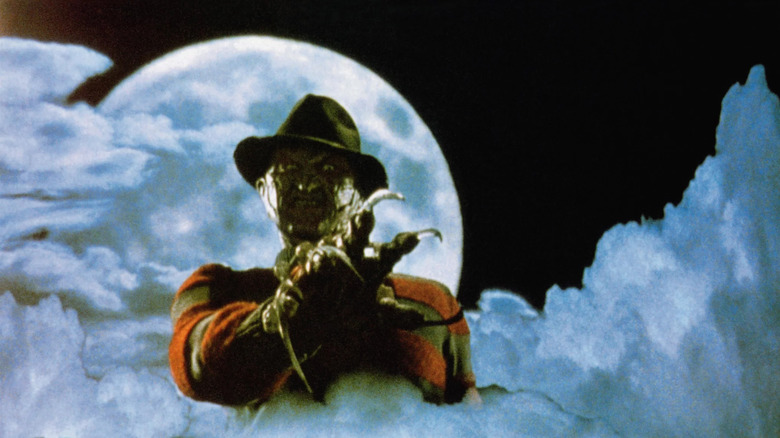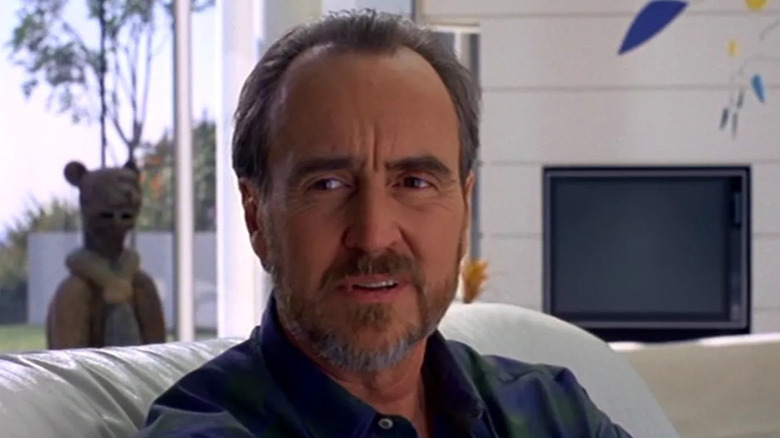How Scream Gave Wes Craven’s New Nightmare A Second Shot At Success

In the annals of horror movie lore, 1996's "Scream" is lauded as a watershed moment in the same league as 1978's "Halloween" or 1968's "Rosemary's Baby." Written by Kevin Williamson and directed by Wes Craven, the movie acts as a sort of meeting of the minds between Williamson's fan of the genre and Craven's veteran of horror, the two artists exploring the tropes and conventions of the genre (and specifically the slasher subgenre) from both sides of the screen.
Yet while "Scream" is given credit for taking horror films into a postmodern, meta, self-referential space, it's far from the first example of such a move in the genre. As horror movies became more prevalent in the mainstream, filmmakers started understanding that horror film audiences were incredibly savvy. Movies like 1981's "Student Bodies," 1986's "Friday the 13th Part VI: Jason Lives" and 1991's "There's Nothing Out There" acknowledged the fact that fans were familiar enough with genre conventions to handle them being played with.
What's more, "Scream" wasn't even Craven's first effort at examining the relationship between horror movies, their creators, and their audience. That honor goes to 1994's "Wes Craven's New Nightmare," the seventh film in the "A Nightmare on Elm Street" series. While "New Nightmare" didn't revolutionize horror the way "Scream" would, the latter's success allowed audiences to rediscover the "Nightmare on Elm Street" sequel and find that in some aspects, "New Nightmare" is actually superior to "Scream."
Craven Gets To Send Freddy Krueger Off His Way

1984's "A Nightmare on Elm Street" essentially transformed fledgling independent distributor New Line Cinema into its own independent powerhouse studio. The popular sentiment became that New Line was "the house that Freddy built," as each successive "Nightmare" sequel continued to rake in loads of cash over relatively modest budgets.
Still, all good things must come to an end, and New Line head Bob Shaye agreed that the sixth film should put a capper on the Krueger saga, resulting in a movie literally titled "Freddy's Dead: The Final Nightmare." Freddy's creator, however, was far from feeling finished with the whole ordeal — in addition to feeling stilted on the business end, Craven also felt he had more to say about the "Nightmare" craze.
In an interview for the franchise's DVD box set, Craven explained how he "called up Bob Shaye and said, 'y'know, I think I wanna make a movie about the phenomenon of the movie and use that as a basis and jump outside the stories entirely.'" The filmmaker also wanted to explore themes of censorship, horror's relationship to audiences, as well as celebrate a full 10 years of "Elm Street." To Craven's delight, Shaye said yes, and "New Nightmare" was shot in early 1994 and subsequently released in October of that year.
Scream Reinvigorates Craven's Career

Unfortunately, "New Nightmare" was not a major hit, grossing only $19.8 million worldwide over an $8 million budget, making it the lowest-earning movie in the entire "Elm Street" series. Craven's follow-up was an attempt by the filmmaker to branch out into broader fare while retaining some horror elements, and though a team-up with star Eddie Murphy seemed like a great idea at the time, the resulting film, "Vampire in Brooklyn," was an even larger flop than "New Nightmare" had been.
Luckily, Craven became attached to a script that had been making the rounds through Hollywood, exciting readers with its knowing attitude toward slasher films. Originally titled "Scary Movie," Craven took Kevin Williamson's script and made "Scream," which was released in December of '96 to fantastic business. The film became a hit in theaters and on home video, helping point audiences back toward Craven's filmography. As his films were rediscovered in "Scream's" wake, everyone from newbies to stalwart horror fans began to realize how much "Scream" was not only not a fluke, but a culmination of themes, ideas and craft that Craven had explored and demonstrated throughout his prior work — especially in "New Nightmare."
New Nightmare Gets The Freddy Stamp Of Approval

In the now 30 odd years since "New Nightmare's" release, praise for the film has only increased, a fact noticed by the man who immortalized Freddy Krueger, actor Robert Englund. Speaking to Daily Dead in 2020, Englund explained how "New Nightmare "— the actor's personal favorite "Elm Street" film — gained new life thanks to "Scream":
"When 'New Nightmare' came out, it was successful, but it wasn't a huge hit. It was just a moderate success. And then Wes Craven's 'Scream' came out and that was even more meta and more deconstructed, but it was a little easier for the audience to digest, and all the characters were people that were self-referencing horror movies and the elements in horror movies. Wes was playing with that in 'New Nightmare' ... Eventually, a lot of the 'Scream' fans started renting 'New Nightmare' and they picked up on just how smart it was."
To Inverse, Englund remarked on how "It's almost like the 'Scream' franchise opened a door of perception for how to watch 'Wes Craven's New Nightmare'," astutely observing how "what happened with that film is we were a tad ahead of our time."
With hindsight, it makes sense why "New Nightmare" was poorly received upon its release — it had to deal with being a sixth sequel that changed series "rules," Freddy fatigue, and more. Yet thanks to "Scream's" evergreen popularity (which includes an ongoing theatrical film series), Craven's movies continue to be discovered and re-evaluated, with "New Nightmare" in particular being seen for the intelligent, scary, and insightful work that it is.
Not only does the film deserve it, but as Craven himself warns in the movie, its success may also be keeping the evil calling itself Freddy Krueger tamed ... for now.
Read this next: The 31 Scariest Movie Scenes Ever
The post How Scream Gave Wes Craven's New Nightmare A Second Shot At Success appeared first on /Film.